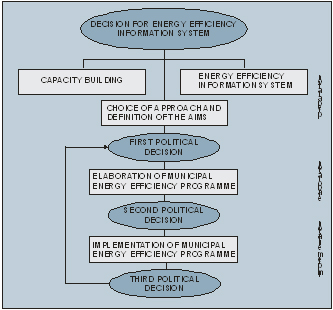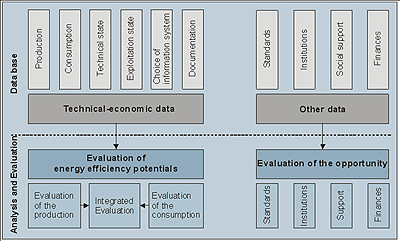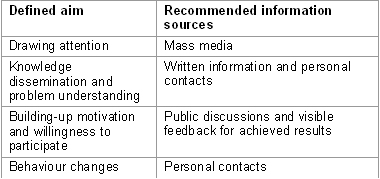 |
 |
 |
 |
 |
 |
 |
 |
 |
 |
 |
 |
Decision making process
Name of the case study
Municipal Energy Efficiency Programme, Municipality of Gabrovo
Decision making process - stages
The implementation of MEEP follows a sequence of political decisions and technical steps:
Step 1 (technical level) - RCPA implemented
• Building-up an information basis for energy planning (structure of energy efficiency information system, database contents, analysis and evaluation of technical information);
• Choice of approach and methodology for elaboration of the programme (possible approaches, method of priority target groups);
• Determination of the aims, scope, impact and participants.
Step 2 (political level)
First political decision – formulating the aims of the Municipal Energy Efficiency Programme. Checking public opinion and attracting public support for the decision is the main part of the precise aims determination.
Step 3 (technical level) - RCPA implemented
• identification of the current state and the scenarios for the programme implementation;
• classification of target groups and objects according their technical-economic potential for increasing energy efficiency;
• assessment of the municipal potential to realise the programme;
• determination of the programme financial framework;
• choice of the priorities and elaboration of the programme.
Step 4 (political level)
Second political decision – approval for the Municipal Energy Efficiency Programme by the Municipal Council; the demonstration projects were accomplished in the meantime.
Step 5 (technical level) - RCPA implemented
Programme implementation (pilot projects, monitoring of the results)
Step 6 (political level)
Third political decision – assessment of the results after the end of the programme. The assessment is accomplished through a comparison of the results, the baseline conditions and the scenario. As a result of the assessment it would be possible to correct the aims and parameters of the programme.
Decision making process - levels
The decision making process covers the political and the technical levels at different stages. (See diagram below).

Process of integrated energy efficiency policy
Decision making process - sources of information
The Municipal Energy Efficiency Information System is used to collect technical and other data (see diagram below) as a basis for the program development, implementation and for monitoring of the results.

Energy efficiency information system
Decision making process - who are the decision makers
The municipal authorities (technical and political level) are the decision-makers.
New administrative structures - energy efficiency offices, are established at the Municipalities according to the inner requirements of EcoEnergy Network regulations. National technical universities, specialized consultancy companies and local NGOs are frequently mobilised in the design and implementation of the municipal energy programs.
Decision making process - who made the final decision for project implementation
The final decision for the programme implementation is made at the political level by the Municipal Council.
Name of tool
Ranking Criteria for Priority Assessment (RCPA)
Decision making process - tools in decision-making process
The tool is used at different stages of the project:
development, implementation and evaluation of the results.
Project Development
• evaluation of existing conditions, choosing of priority areas and target groups. Analyses are based on: (i) technical and economic criteria - assessment of the potential for increasing the energy efficiency in single objects, different targets group and target sectors; (ii) political, regulation, social and environmental factors - assessment of the municipalities’ potential for implementation of the Energy Efficiency Programme;
• comparison of the target groups is made according to "weight coefficient" for: energy consumption, municipality´s influence, willingness for participation in the programme;
• Identification of further activities – technical, regulation and organisational measures, stimuli, etc.
The implementation of the program also depends on the choice of actors involved: new and existing municipal structures, local energy companies, outer consultants (private companies, NGOs, agencies, etc.), local community.
Monitoring and evaluation of the results:
• updating of the database;
• assessment of the qualitative changes;
• influence on other sectors (not fully assessed yet).
The evaluation results are available to the public, which makes the process transparent. Increased public awareness of energy efficiency issues after the implementation of the programme was not been specially measured but municipal authorities reported public readiness to join in activities aimed at energy efficiency to be rising.
Quantitative goals are defined at the beginning of the project comprise economic and environmental indicators, based on the programme aims and national standards.
More than 30 Bulgarian municipalities have already developed their Energy Efficiency Programs. Half of these have been approved by the Municipal Councils and are successfully implemented. The results of the implementation in different municipalities were later compared and that contributed to making the tool and the programme more flexible.
The analysis results and actions included in the programme provide support to attract the investments in municipal energy sector.
Decision making process - how was the information for the dmp disseminated
The information about the political decision concerning the Programme implementation was directly disseminated by the Municipality to the public. when its own capacity to accomplish communication strategy is estimated to be high enough. The collaboration with the specialised NGO EnEffect was considered particularly helpful for increasing public awareness on the issues of energy efficiency.
The information sources chosen depend on the aims defined. The guidance for Municipality Energy Efficiency Programme (MEEP) implementation recommends an "aim – source" matrix.

"Aim – source" matrix
Decision making process - how was the public involved
It is established that the degree of public awareness and involvement varies in different target groups. The chosen communication patterns and intensity depends of the commitment degree of each group concerning a particular energy problem.
Decision making process - was there public discussion over the project
Public discussions accompanied the development and implementation of the projects in residential buildings.
What tools were used to assess sustainability?
Ranking Criteria for Priority Assessment (RCPA)
More information